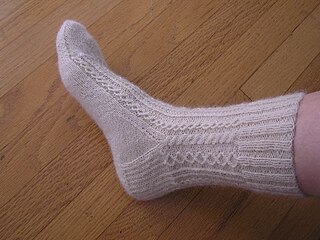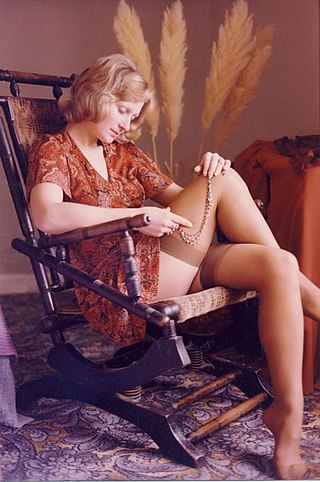
Foot fetishism, also known as foot partialism or podophilia, is a pronounced sexual interest in feet. [1] [2] It is the most common form of sexual fetishism for otherwise non-sexual objects or body parts. [3]

Foot fetishism, also known as foot partialism or podophilia, is a pronounced sexual interest in feet. [1] [2] It is the most common form of sexual fetishism for otherwise non-sexual objects or body parts. [3]
Foot fetishism has been defined as a pronounced sexual interest in feet. For a foot fetishist, points of attraction may include the shape and size of feet, feet soles, toes, jewelry (e.g., toe rings, anklets, etc.), treatments (such as massaging, washing partner's feet or painting partner's toenails), state of dress (e.g., barefoot, flip flops, boat shoes, ballet flats, sandals, high heels, [4] clogs, hosiery, socked feet, etc.), foot odor or sensory interaction (e.g., rubbing the foot, smelling, tickling, licking, rubbing genitals on foot, etc.). [5]
Extensions of this fetish include shoes, socks, olfactophilia (odor fetishism), and tickling. Sigmund Freud also considered foot binding as a form of fetishism, [6] [7] although this view was disputed. [8]
Odor fetishism (pertaining to the smell of feet) seems to play a major role in foot fetishism, and is closely related to it: in a 1994 study, 45% of those with a foot fetish were found to be aroused by smelly socks or feet, making it one of the most widespread forms of olfactophilia. [9]
In extreme cases, an individual with a pronounced sexual interest in feet could possibly be diagnosed with fetishism disorder (characterized by the eroticization of non-living objects and body parts) if they are in adherence with the following symptoms: [10]
To estimate the relative frequency of fetishes, in 2006 researchers at the University of Bologna examined 381 Internet discussions of fetish groups, in which at least 5,000 people had been participating. Researchers estimated the prevalence of different fetishes based on the following elements:
It was concluded that the most common fetishes were for body parts or for objects usually associated with body parts (33% and 30%, respectively). Among those people preferring body parts, feet and toes were preferred by the greatest number, with 47% of those sampled preferring them. Among those people preferring objects related to body parts, 32% were in groups related to footwear (shoes, boots, etc.). [3]
Foot fetishism is the most common form of sexual fetish related to the body. [11]
In August 2006, AOL released a database of the search terms submitted by their subscribers. In ranking only those phrases that included the word "fetish", it was found that the most common search was for feet. [12]
Foot fetishism may be more common in men than in women. Researchers using a polling agency to conduct a survey of the general Belgian population in 2017 found that 76 of the 459 male respondents (17%) and 23 of the 565 female respondents (4%) answered "Agree" or "Strongly agree" to a fetish interest in feet. [13]
Similar to other forms of sexual fetishism, no consensus has yet been established about the specific causes of foot fetishism. While many works on the topic exist, their conclusions are often regarded as highly speculative.[ citation needed ] In a general sense, sexual fetishism can be caused by a number of factors, no singular cause for any type of fetishism has been conclusively established. [14]
Foot fetishism may be caused by the feet and the genitals occupying adjacent areas of the somatosensory cortex, possibly entailing some neural crosstalk between the two. [15] Neuroscientist V. S. Ramachandran proposed that an accidental link between these regions could explain the prevalence of foot fetishism. [16]
Desmond Morris considered foot fetishism the result of mal-imprinting at an early age, the tactile pressure of a foot/shoe being important in this. [17] Freud's reading of foot fetishism also involved early imprinting, but he considered the smell of feet significant in this, as well as the foot as a penis-symbol/surrogate (castration complex, especially when encountered while voyeuristically exploring the female body from below). [18] Otto Fenichel similarly saw castration fear as significant in foot fetishism, citing a future fetishist who as an adolescent said to himself "You must remember this throughout life – that girls, too, have legs", to protect himself from the fear. [19] Where fear of the (castrated) female body is too great, desire is felt not for shoes on female feet but for women's shoes alone, without women. [20]
Georges Bataille saw the lure of the feet as linked to their anatomical baseness (abjection). [21]
Some researchers have hypothesized that foot fetishism increases as a response to epidemics of sexually transmitted infections. In one study, conducted by A James Giannini at Ohio State University, an increased interest in feet as sexual objects was observed during the great gonorrhea epidemic of twelfth-century Europe, and the syphilis epidemics of the 16th and 19th centuries in Europe. [22] In the same study, the frequency of foot-fetish depictions in pornographic literature was measured over a 30-year interval. An exponential increase was noted during the period of the current AIDS epidemic. In these cases, sexual footplay was viewed as a safe sex alternative. [23] However, the researchers noted that these epidemics overlapped periods of relative female emancipation. [24]
Some of the earliest recorded instances of foot fetishism occur in the erotic poems To a Barefoot Woman and To a Barefoot Boy attributed to the Ancient Greek writer Philostratus. [25] [26] The Hindu god Brahma was aroused by the sight of Parvati's feet in the eighth-century text Skanda Purana . [27]
Fetish may refer to:

Footwear refers to garments worn on the feet, which typically serve the purpose of protection against adversities of the environment such as wear from rough ground; stability on slippery ground; and temperature.

A fetish model is a model who models fetish clothing or accessories that augment their body in a fetish-like manner or in fetishistic situations. Fetish models do not necessarily work exclusively in that form of modeling.

Sexual fetishism or erotic fetishism is a sexual fixation on a nonliving object or nongenital body part. The object of interest is called the fetish; the person who has a fetish for that object is a fetishist. A sexual fetish may be regarded as a non-pathological aid to sexual excitement, or as a mental disorder if it causes significant psychosocial distress for the person or has detrimental effects on important areas of their life. Sexual arousal from a particular body part can be further classified as partialism.

A boot is a type of footwear. Most boots mainly cover the foot and the ankle, while some also cover some part of the lower calf. Some boots extend up the leg, sometimes as far as the knee or even the hip. Most boots have a heel that is clearly distinguishable from the rest of the sole, even if the two are made of one piece. Traditionally made of leather or rubber, modern boots are made from a variety of materials.

Shoe fetishism is the attribution of attractive sexual qualities to shoes or other footwear as a matter of sexual preference, or an alternative or complement to a relationship with a partner. It has also been known as retifism, after the French novelist Nicolas-Edme Rétif (1734–1806), also known as Rétif de la Bretonne, who wrote a novel about it called Fanchette's Foot, which preference or penchant seems to have been if not "all the rage" at the time at least known to have been practiced or suffered by more than handsful of somewhat important individuals of that period.
Trampling is a sexual activity that involves being trampled underfoot by another person or persons. Trampling is common enough to support a subgenre of trampling pornography.

Smoking fetishism is a sexual fetish based on the pulmonary consumption (smoking) of tobacco, most often via cigarettes, cigars, cannabis and also pipes, vapes, and hookahs to some extent. As a fetish, its mechanisms regard sexual arousal from the observation or imagination of a person smoking, sometimes including oneself.

Boot fetishism is a sexual fetish focused on boots. Boots have become the object of sexual attraction amounting to fetishism for some people and they have become a standard accessory in BDSM scenes and a fashion accessory in music videos. Boots are seen as perhaps the most fetishistic of all footwear and boots are the most popular fetish clothing attire.
A crush fetish is a fetish and a paraphilia in which sexual arousal is associated with observing objects being crushed or being crushed oneself. The crushed objects vary from inanimate items, to injurious and/or fatal crushing of invertebrates, or vertebrates.

Erotic humiliation is a consensual psychological humiliation performed in order to produce erotic excitement or sexual arousal. This can be for either the person(s) being humiliated and demeaned or the person(s) humiliating, or both. It is sometimes performed before spectators, including through pornography and webcam modeling. It may be part of BDSM and other sexual roleplay, or accompanied by the sexual stimulation of the genitals of one or both parties in the activity.

Hair fetishism, also known as hair partialism and trichophilia, is a partialism in which a person sees hair – most commonly, head hair – as particularly erotic and sexually arousing. Arousal may occur from seeing or touching hair, whether head hair, armpit hair, chest hair or fur. Head-hair arousal may come from seeing or touching very long or short hair, wet hair, certain colors of hair or a particular hairstyle.
The ballet boot is a contemporary style of fetish footwear that merges the look of the pointe shoe with a high heel. The idea is to restrict the wearer's feet almost en pointe, like those of a ballerina, with the aid of long, slender heels. When upright, the feet are held nearly vertical by the shoe, thus putting nearly all of the body's weight on the tips of the toes. However, a properly tight fit will hold the shoe to the wearer's instep and heel, thereby reducing the weight on the wearer's toes.

Navel fetishism, belly button fetishism, or alvinophilia is a partialism in which an individual is attracted to the human navel.

Hand fetishism, hand partialism or cheirophilia is the sexual fetish for hands. This may include the sexual attraction to a specific area such as the fingers, palm, back of the hand and/or nails, or the attraction to a specific action performed by the hands; which may otherwise be considered non-sexual—such as washing and drying dishes, painting of the fingernails and nail-biting. This fetish may manifest itself as a desire to experience physical interaction, or as a source of sexual fantasy.

Clothing fetishism or garment fetishism is a sexual fetish that revolves around a fixation upon a particular article or type of clothing, a particular fashion or uniform, or a person dressed in such a style.

Armpit fetishism is a type of partialism in which a person is sexually attracted to armpits, which may lead to armpit intercourse.

A sock is a piece of clothing worn on the feet and often covering the ankle or some part of the calf. Some types of shoes or boots are typically worn over socks. In ancient times, socks were made from leather or matted animal hair. In the late 16th century, machine-knit socks were first produced. Until the 1800s, both hand-made and machine-knit socks were manufactured, with the latter technique becoming more common in the 19th century, and continuing until the modern day.

Underwear fetishism is a sexual fetishism relating to undergarments, and refers to preoccupation with the sexual excitement of certain types of underwear, including panties, stockings, pantyhose, bras, or other items. Some people can experience sexual excitement from wearing, while others get their excitement when observing, handling, or smelling the underwear worn by another, or watching somebody putting underwear on or taking it off.
Foot odor or bromodosis is a type of body odor that affects the feet of humans.
![]() Media related to foot fetishism at Wikimedia Commons
Media related to foot fetishism at Wikimedia Commons